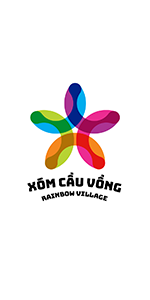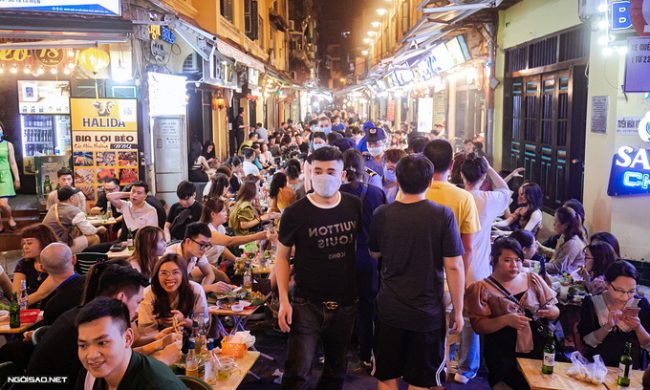According to VnExpress International – Over the past two years, with more resolve than resources, the Vietnamese government and people have managed to contain the coronavirus while also keeping the economy afloat.
Last Saturday morning, Tran Thi Ngoc Lan from HCMC’s District 3 ran downstairs to join her neighbors for a jog at Tao Dan Park. Afterwards, the 32-year-old woman and her friends headed to a crowded eatery nearby to chow down a hot bowl of pho for breakfast.
At the eatery, the gang found many customers awaiting their turn, some without their masks on and many not keeping a safe distance. Tired after her long run, Lan also took off her mask, no longer worried about the Covid-19 pandemic.
“One or two years ago, I was rattled,” Lan said. “But I’m fully vaccinated and things are different now.”
Though Vietnam has still recorded about 166,000 new infections every day for the past seven days, many people like Lan are feeling relaxed and confident, believing they can coexist with the coronavirus and regain control of their lives.
This is a far cry from the suspense and anxiety of early 2020 when Vietnam recorded its first cases of coronavirus infection.
One long white night
In Hanoi, many residents still remember the emergency meeting that municipal authorities called at midnight on March 6 to discuss immediate preventive measures to contain the public transmission caused by a woman, the capital’s first confirmed case.
Young and wealthy, she had returned home on March 2 after traveling around Europe, including high-risk Italy.
At the airport, she did not make an accurate health declaration and consequently escaped quarantine. She went home, felt sick, went to the hospital, and was diagnosed with Covid.
Hanoi went into an uproar. The whole neighborhood where she lived was sealed and sanitized, over 200 people who had been in contact with her were traced, tested and quarantined, and many businesses in places she had traveled were shut to minimize infections. Hanoians started to stockpile food on panic, and social media criticized the patient for her behavior.
The situation was however gradually brought under control. The patient and 414 others who were infected in the first wave between late January and late July 2020 were provided with good care and eventually discharged from hospital safe and sound.
Vietnam was nimble, alternating between stringent preventive measures and resuming activities when appropriate, and, remarkably, went through the global pandemic with no deaths in the first and third waves.
There were 35 deaths in the central Da Nang City in the second wave, and over 6.8 million infections and 41,000 deaths in the ongoing fourth wave with the Delta and Omicron variants, according to the Ministry of Health.
Balancing twin goals
As the coronavirus spread quickly in late 2019 from the Chinese city of Wuhan first to neighboring countries and then 201 countries and territories worldwide, Vietnam’s handling of the first wave was widely reported and praised.
The government’s leadership was hailed by the international community as quick, effective and frugal, and as showing “how to do more with less,” by the World Economic Forum.
Assoc Prof Dr Tran Dac Phu, a former director of the Ministry of Health’s department of preventive medicine, said in those early months when people were yet to be vaccinated, Vietnam prioritized public health over the economy.
 |
“The government instructed local authorities to coordinate and carry out measures such as tracing and selective testing to contain and treat infections,” Phu said.
“At that time, prevention was the first and foremost goal.”
Indeed, the government acted early, forestalling sources of infection, testing, and isolating infected patients in designated centers, cordoning off and sanitizing high-risk areas, and coordinating health services to treat serious cases.
Vietnam often had more stringent measures and earlier than advised by the World Health Organization (WHO), including being the first country to require mandatory health declarations for all foreign arrivals, which it did in early March 2020.
The government also suspended all international flights, shut down schools, and quarantined for 21 days a whole commune in the northern Vinh Phuc Province where a group of workers coming from abroad created Vietnam’s first Covid hotspot.
But these tough measures were alternated with easing up whenever possible to balance the government’s twin goals of protecting public health and maintaining economic growth.
For instance, Phu pointed out, after people started to be vaccinated, infected patients were gradually allowed to be treated at home rather than at medical centers and business activities were allowed to resume.
Though this seesaw approach has not always worked smoothly and included some rash policies like the National Administration of Tourism campaign called ‘Vietnam – Safe Haven’ to attract foreign tourists in February 2020 when the pandemic was still in its early stage and which caused a spike in new infections, Vietnam managed to achieve 2.9 percent GDP growth in 2020, a rare feat then, and 2.6 percent last year.
Phu also pointed out other shortcomings such as the delayed and inaccurate prediction of the Delta variant that caused great havoc in HCMC during the fourth wave, and the uneven implementation of social distancing while still maintaining production by businesses.
“Some companies handled this well, some not so well. But no one has been able to respond perfectly throughout this pandemic.”
During the pandemic, government actions received wholehearted public support.
In fact in a survey of 45 countries carried out by Germany-based Dalia Research in March 2020, the biggest global survey on coronavirus at the time, 62 percent of Vietnamese respondents, the highest rate of any country, thought their government was responding adequately to the situation.
Unlike in some western countries where government mandates became extremely politicized, most Vietnamese willingly wore masks, followed safety rules, and, starting in March 2021, got vaccinated to protect themselves and others.
In July 2021 Vietnam started its biggest vaccination campaign in history, mobilizing tens of thousands of medical centers and workers to vaccinate everyone aged 18 years and above, or around 75 million people.
Since then 79 percent of the population has been fully vaccinated, which Phu says is among the highest rates in the world.
And for the first time a group of Vietnamese doctors from HCMC’s Pasteur Institute and Cho Ray Hospital had a research paper published in the prestigious The New England Journal of Medicine. It was about the country’s first two Covid infections.
According to a study led by a team of researchers from Hanoi’s Plenikaa University on the first wave, Vietnam’s response was marked by co-ordination between the government, civil society and individuals.
Thanks to previous experiences in dealing with SARS in 2003, the H5N1 flu in 2008 and influenza A/H1N1 in 2009 and 2018, the government treated coronavirus with far-sightedness, considering it a lasting rather than temporary epidemic, it said.
 |
Consequently, government actions were comprehensive in terms of health, social and economic aspects. Bank loans were rolled over, interest rates were cut and hundreds of trillions of dong (VND1 trillion = $43.7 million) were set aside to assist businesses and individuals in terms of both finances and welfare.
During nationwide lockdowns, the government and the private sector acted quickly to ensure adequate supply of essential goods, prevent panic buying and speculation and keep prices steady, the study observed.
The study, titled ‘Policy Response, Social Media and Science Journalism for the Sustainability of the Public Health System Amid the Covid-19 Outbreak: The Vietnam Lessons,’ said the media too responded promptly, providing plenty of scientific information about the coronavirus and helping prepare the public to react with relative calmness to the pandemic.
Indeed, scientific information was often simplified into memorable soundbites to be circulated on both mainstream and especially social media to raise public awareness about Covid prevention.
One well-known example was the handwashing song “Ghen Co Vy” that songwriter Khac Hung adapted from his earlier pop hit, “Ghen” (Jealousy) in a media campaign carried out by the health ministry’s National Institute of Occupational and Environmental Health.
Popular dancer Quang Dang choreographed the song and posted his moves on TikTok, immediately sparking a viral challenge with many people around the world posting their own covers. It, in 2020, was broadcast on HBO’s Last Week Tonight with John Oliver, who praised Vietnam for many useful propaganda measures on the disease.
From notorious infection to ongoing adaptation
However, the usual suspects in the foreign media had to portray Vietnam’s response in an unflattering light, emphasizing its collective ability to make and enact decisions promptly and a “surveillance” culture in which any wrongdoing that affects public safety is promptly reported.
For instance, in 2020 The New Yorker magazine published an article titled ‘The Public-Shaming Pandemic’ that quoted Hanoi’s first Covid patient and her sister who criticized Vietnamese culture and people for hunting her out online and being disrespectful of people’s privacy and jealous of their upper-class background.
The baseless disparagement drew another angry backlash from Vietnamese readers who pointed out that the criticism of the patient and public anxiety in the early phase of the pandemic were justified and appropriate.
Today, with the pandemic declining and the economy opening up, the response is measured and appropriate for the situation.
Tension and anxiety have given way to confidence and ease.
People like Lan and her friends in HCMC, who have caught Covid and recovered, are going out and having fun again.
Others, who are also fully vaccinated, often casually ask their friends and relatives: “Have you had Covid yet?”

